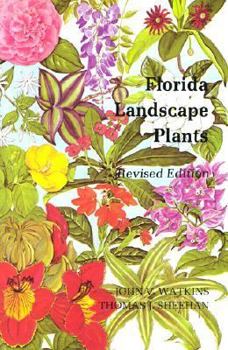Florida Landscape Plants: Native and Exotic
Select Format
Select Condition 
Book Overview
"An indispensable reference. . . . Every Florida gardener should have this book."-- Florida Times-Union "If you live in Florida, this book is for you. . . . It is the best book I have seen on the... This description may be from another edition of this product.
Format:Paperback
Language:English
ISBN:0813008611
ISBN13:9780813008615
Release Date:November 1986
Publisher:University Press of Florida
Length:420 Pages
Weight:1.35 lbs.
Dimensions:1.2" x 6.0" x 9.0"
Customer Reviews
5 ratings
Florida Landscape Plants: Native and Exotic
Published by Thriftbooks.com User , 17 years ago
I bought this book about 10 years ago and it turned into my Florida "Bible". Just about every plant, especially garden plants, is included. On one page you can see all the necessary information that is needed to be a successful Florida gardener. I loaned it to a friend, a plant "nut", recently transplanted from Pennsylvania. She was trying to grow plants the old northern way, which wasn't working out. Eventually success is growing in her garden. The book became a Christmas gift and a "Welcome to Florida" gift (and a gift for me, my old book is very worn) this year. Use it and enjoy.
The Florida plant chronicles
Published by Thriftbooks.com User , 18 years ago
FLORIDA LANDSCAPE PLANTS lists native and non-native plants growable in the northern, central or southern parts of the state. It's an updated version of the late Professor John V Watkins' book. Professor Watkins taught landscape horticulture at the University of Florida. But he was well known outside the campus, for his gardening- and landscape-related radio series and writings published as books and magazine articles. Professors Thomas J Sheehan and Robert J Black fill the empty space left with Professor Watkins' death. They've added to and modernized his classic landscape plant manual. Throughout, they've stayed true to Professor Watkins' original mission of writing for an audience of university students, nurserymen, master gardeners, and homeowners of our Gulf states. Their book is nicely organized for that purpose. There's a listing of over 400 plants. The book closes with a helpful model planting guide, list of invasives, glossary, and an index of common and scientific names. Their book gives more information and puts in more plants than the original work by Professor Watkins. But their book isn't comprehensive. It's not a case of everything Professor Watkins listed, along with add-ons. In fact, they've left out some "old favorites," partly because some have been called "invasive" by the Florida Exotic Plant Council. In part, too, they wanted the book to fall within the page range known as "popular size." FLORIDA LANDSCAPE PLANTS is nevertheless very workable, with a lot of clearly illustrated and organized information and with no useless information. Each plant is listed by common name. The scientific name is given below, with the way to say it and the English meaning. There's also a sketch of each plant. I miss the beauty of color drawings and photos. But the black-and-whites are so well done that the plants should be easily known by form and shape, often more telling than color. The information is conveniently slotted into family; relatives; type of plant; height [in Florida]; zone [in north, central or south Florida]; how to identify; habit of growth; foliage; flowers; fruits; season of maximum color; landscape uses; habitat; light and soil requirement; salt tolerance; availability; culture; propagation; and pests. Sometimes, there's a note slot, such as for sweet acacia "This plant is cultivated in the south of France for its flowers, which are made into a very fine perfume." FLORIDA LANDSCAPE PLANTS would be an interesting read not only for gardeners and landscapers. I was impressed with how many of the plants are already common household words as household plants: Dieffenbachia, ficus, jade plant, spider plant, and wandering jew. Others are already known as "public places" trees, such as my favorites: American hornbeam, black olive, geiger, gumbo limbo, lignum vitae, red maple, river birch, and southern magnolia. Still others are already known as rock garden plants, such as my favorites: agave, aloe, aluminum plant, bush zinnia,
Helpful for the new Florida resident
Published by Thriftbooks.com User , 18 years ago
I purchased this book because it was highly recommended in a Florida Gardening magazine. I am new to Florida recently moving here from the Northeast. I was looking for someway to link plants I see in neighbors' yards with what might work in our spaces. The only thing I was disappointed in is that the book's pictures are not in color. Colors would help me better link plants I see with what's in the book.
Florida Landscape Plants
Published by Thriftbooks.com User , 24 years ago
This is a worthwhile book for a number of reasons, however, it has one major omission. The positive factors: 1) Excellent plant descriptions including details like salt tolerance level; 2) wonderful (and most appreciated) treatment of botanic names by giving the pronunciation and derivation of the Latin words (Thanks!). The omission concerns color photographs of the plants discussed. The publisher included a few color pages of plant drawings which are mostly useless and confusing. A good garden book needs to have extensive color photographs. I am sure that the author would agree!!
The absolute last word on Florida Landscape Plants!
Published by Thriftbooks.com User , 24 years ago
This is the text book used to teach horticulture classes and plant identification at the University of Florida. All Horticulture graduates and Landscape Architecture graduates at UF have studied from this book. Dr.s Watkins and Sheehan have put more than 5 decades of combined Florida horticultural expertise into this book.





